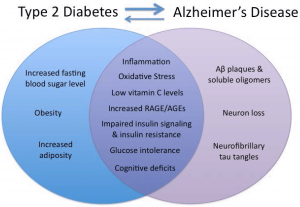
http://www.mwhomecare.com/diabetes-alzheimers-study/
What is Alzheimer’s Disease? Most likely when you first encountered Alzheimer’s, you heard that it was an individual forgetting things that they had previously known, such as names, events, or even large portions of their lives. The first thought after that is probably: Why? How does this happen in a person’s head? There are two big things that have been found to contribute to Alzheimer’s: neurofibrillary tangles and Aβ plaques.
Neurofibrillary tangles are hyperphosphorylated aggregates of tau protein that come together as insoluble clumps due to problems caused by insulin resistance. These insoluble tangles increase toxicity in the brain and cause neurons in the brain to die. With less neurons in the brain, connections are less easily made and symptoms of Alzheimer’s start to show.
Aβ plaques are collections of amyloid beta peptide oligomers that clump together because of improper cutting of an amyloid precursor protein (APP). This improper cutting is due to a buildup of the GM3 ganglioside. This also causes the insulin receptor to be unable to receive insulin. Then insulin resistance increases.

https://healclinics.com/a-relationship-between-diabetes-and-alzheimers-disease/
Now how does this relate to Type 2 Diabetes? The answer is insulin resistance. Type 2 Diabetes is characterized as your body being unable to use insulin in the correct way. When it can’t be used, it can’t regulate our blood sugar levels causing hyperglycemia, or higher blood sugar levels than normal. We know that insulin is important in maintaining our blood sugar levels; but being a big part of the brain? That is a new idea. Insulin is made in two parts of the body: the pancreas and the brain. It is an important regulator of brain physiology and works as a cognitive enhancer. So if there is resistance to this cognitive enhancer, there will be breakdown in the brain: Alzheimer’s Disease. We see that both the neurofibrillary tangles and Aβ plaques are fundamentally involved in some way, shape, or form with insulin resistance.

http://www.drugood.com/2018/05/30/is-alzheimers-disease-called-type-iii-diabetes/
Now that we have talked a little bit about both Alzheimer’s and Type 2 Diabetes, we can see that there is a connection between the two. That connection being insulin resistance. However, it goes even deeper. Studies show that 70% of all individuals that have Type 2 Diabetes will develop Alzheimer’s Disease at a later time in their lives. That number is staggering to me and it makes me think we need to make some changes at both the individual and societal levels. Individually we need to think about what we eat and get more exercise. Since Type 2 Diabetes is largely characterized by unhealthy eating and lack of exercise, this would be the obvious place to begin. At the societal level, we need to have healthy options available as fast options, not only unhealthy options. Though much of our society is in a “go-go-go” mode, we still need to have a healthy food to fuel us through our days. Though this won’t completely fix the problem, it will likely be worth it to slow down the large numbers that are developing Type 2 Diabetes and in the future Alzheimer’s. I feel that this ‘risk’ of healthy eating and exercise is worth it to remember loved ones and large events that happen in your life.